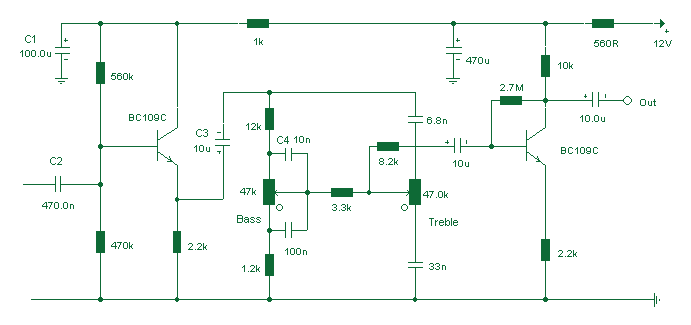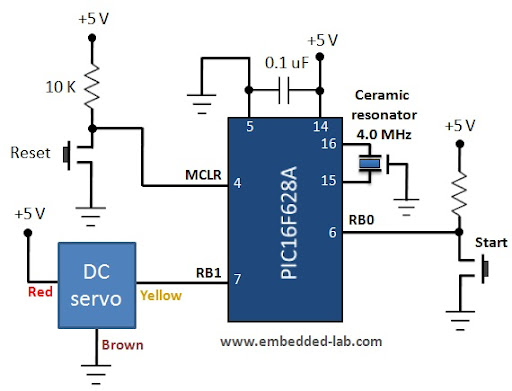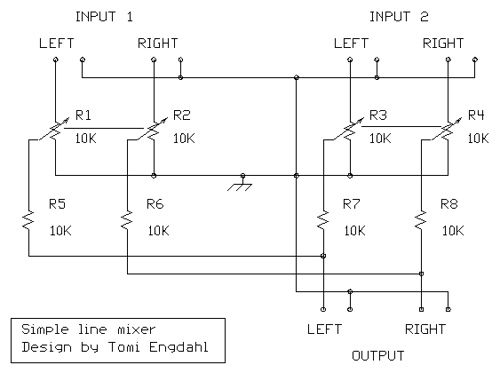
Audio Tone Control

Based on the classic Baxendall tone control circuit, this provides a maximum cut and boost of around 10dB at 10K and 50Hz. The first BC109C transistor (left hand side) is acting as a buffer. It provides the circuit with a high input impedance, around 250k has a voltage gain of slightly less than unity. More: As the Baxendall tone control circuit is a passive design, all audio frequencies are attenuated. The position of the controls and reactance of the capacitors alters the audio response. The last transistor provides a slight boost of about 3x. The output is
The described circuit is a Baxendall tone control circuit, which is renowned for its ability to adjust audio frequencies with precision while maintaining a flat response at the center frequency. This circuit employs a BC109C transistor as an input buffer, which is critical for maintaining high input impedance and ensuring that the signal is not significantly loaded by the subsequent stages. The input impedance of approximately 250kΩ allows for compatibility with various audio sources without degrading the signal quality.
The core of the Baxendall design features passive components, specifically resistors and capacitors, which dictate the frequency response of the circuit. The arrangement of these components allows for a maximum cut and boost of around 10dB at two specific frequencies: 10kHz and 50Hz. This characteristic makes the circuit particularly useful in applications where bass and treble adjustments are required, such as in audio mixing consoles or home audio systems.
The tone control circuit operates by varying the reactance of the capacitors in conjunction with the resistors, which in turn modifies the audio signal's frequency response. This interaction allows users to enhance or attenuate specific frequency ranges, thus shaping the overall sound character.
At the output stage, an additional transistor provides a gain of approximately three times the input signal, ensuring that the final output level is adequate for driving subsequent audio processing stages or amplifiers. The combination of passive tone control and the active gain stage allows for a versatile and effective audio processing solution, suitable for both professional and consumer audio applications.
In summary, the Baxendall tone control circuit effectively balances high input impedance, flexible frequency response adjustments, and sufficient output gain, making it an essential component in audio engineering.Based on the classic Baxendall tone control circuit, this provides a maximum cut and boost of around 10dB at 10K and 50Hz. The first BC109C transistor (left hand side) is acting as a buffer. It provides the circuit with a high input impedance, around 250k has a voltage gain of slightly less than unity.
As the Baxendall tone control circuit is a passive design, all audio frequencies are attenuated. The position of the controls and reactance of the capacitors alters the audio response. The last transistor provides a slight boost of about 3x. The output is 🔗 External reference
The described circuit is a Baxendall tone control circuit, which is renowned for its ability to adjust audio frequencies with precision while maintaining a flat response at the center frequency. This circuit employs a BC109C transistor as an input buffer, which is critical for maintaining high input impedance and ensuring that the signal is not significantly loaded by the subsequent stages. The input impedance of approximately 250kΩ allows for compatibility with various audio sources without degrading the signal quality.
The core of the Baxendall design features passive components, specifically resistors and capacitors, which dictate the frequency response of the circuit. The arrangement of these components allows for a maximum cut and boost of around 10dB at two specific frequencies: 10kHz and 50Hz. This characteristic makes the circuit particularly useful in applications where bass and treble adjustments are required, such as in audio mixing consoles or home audio systems.
The tone control circuit operates by varying the reactance of the capacitors in conjunction with the resistors, which in turn modifies the audio signal's frequency response. This interaction allows users to enhance or attenuate specific frequency ranges, thus shaping the overall sound character.
At the output stage, an additional transistor provides a gain of approximately three times the input signal, ensuring that the final output level is adequate for driving subsequent audio processing stages or amplifiers. The combination of passive tone control and the active gain stage allows for a versatile and effective audio processing solution, suitable for both professional and consumer audio applications.
In summary, the Baxendall tone control circuit effectively balances high input impedance, flexible frequency response adjustments, and sufficient output gain, making it an essential component in audio engineering.Based on the classic Baxendall tone control circuit, this provides a maximum cut and boost of around 10dB at 10K and 50Hz. The first BC109C transistor (left hand side) is acting as a buffer. It provides the circuit with a high input impedance, around 250k has a voltage gain of slightly less than unity.
As the Baxendall tone control circuit is a passive design, all audio frequencies are attenuated. The position of the controls and reactance of the capacitors alters the audio response. The last transistor provides a slight boost of about 3x. The output is 🔗 External reference





